Pacific bluefin tuna have surged in numbers off Southern California over the past five years, opening up phenomenal angling opportunities. Though most fish weigh under 100 pounds, some exceed 200 and even 300 pounds.
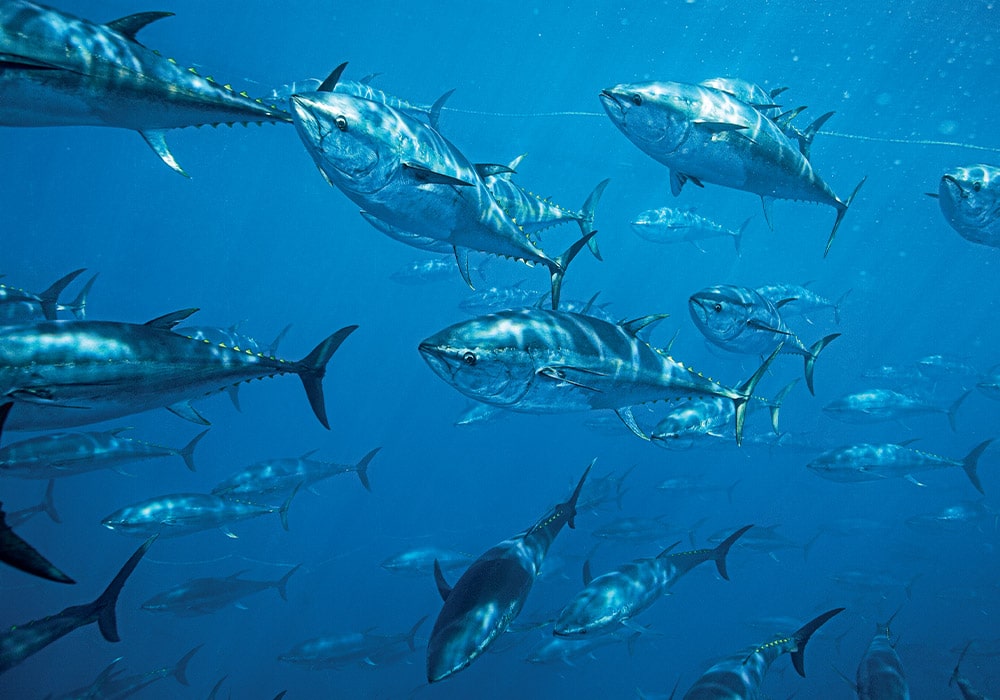
This is sure to send hordes of anglers seaward eager to catch their share using a wide range of techniques, from night-fishing with metal jigs such as Flatfalls to trolling with kites and plastic flying-fish lures.
“You never know what it’s going to take to entice a Pacific bluefin; it changes year to year, throughout a season, and even throughout a single day,” says Greg Stotesbury, tackle sales and clothing promotions manager for AFTCO in Santa Ana, California.
Yet Stotesbury and his brother Michael know more than most when it comes to catching Pacific bluefins. Fishing aboard their 33-foot Owens Brigantine Flying Fish, they landed numerous big tuna over the past few seasons. Last year, the largest was 258 pounds, and they lost at least one fish over 300.
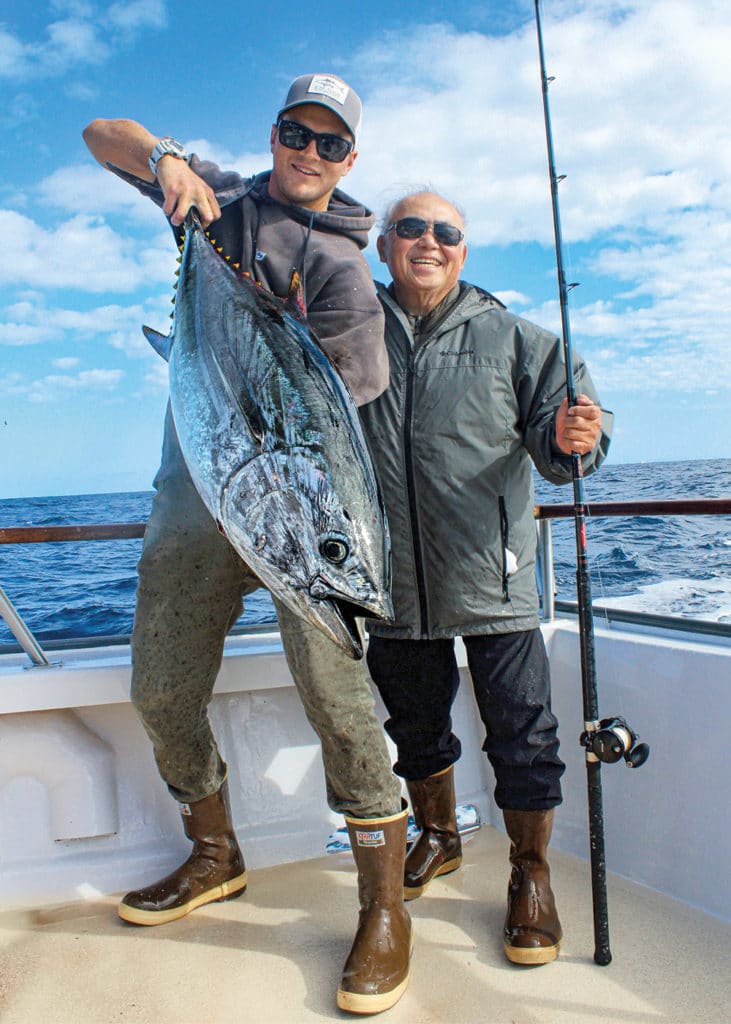
Evolving Techniques The Stotesbury-team techniques last year are a far cry from those originally used when bluefins first appeared off Southern California around 2013.
“Our bluefin tuna techniques have evolved,” Stotesbury says. “We started off running-and-gunning, to cast poppers or live mackerel to them. Now we rarely do that.”
That’s not to say that running-and-gunning and kite-trolling won’t catch fish. But with new techniques focused on unexpected fishing areas, these two are catching more and larger bluefin tuna than ever before.
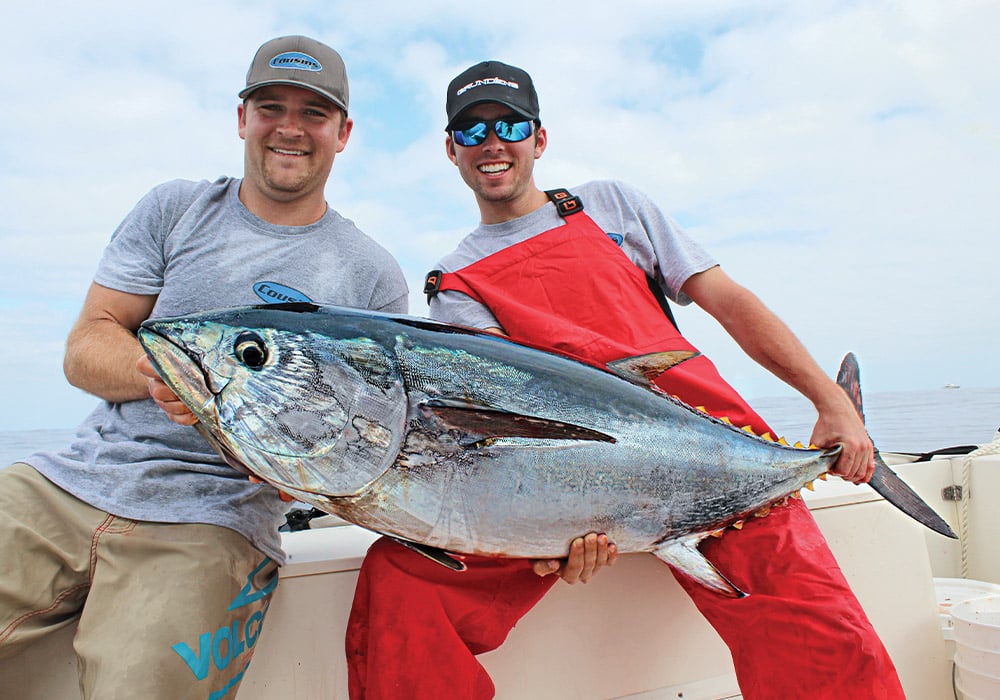
Shallow Thinking The waters around San Clemente Island, roughly 50 miles from the mainland, have been among the most productive for bluefins over the past few seasons. The schools of tuna seem to settle here during summer and fall, roaming nearby seamounts, trenches and ledges, such as Emery Knoll (aka Mackerel Bank), the 289 Bank and San Clemente Canyon, in depths from 2,000 to 4,500 feet.
However, the waters closer to the island in 300 to 600 feet tend to produce some of the largest tuna. “The bigger fish tend to hang tight to the island,” Stotesbury says.
While the chances of hooking up improves in these depths, it’s at the peril of losing a hooked fish as it sounds and snags the line on rocks, deep coral or kelp.
California sea lions also pose an issue when baitfishing close to the island, often nipping at or tearing loose bait slow-trolled or drifted for bluefin tuna. “Sea lions can be a big nuisance when fishing close to the island,” Stotesbury points out. “But we put up with it for a chance to hook a big fish.”
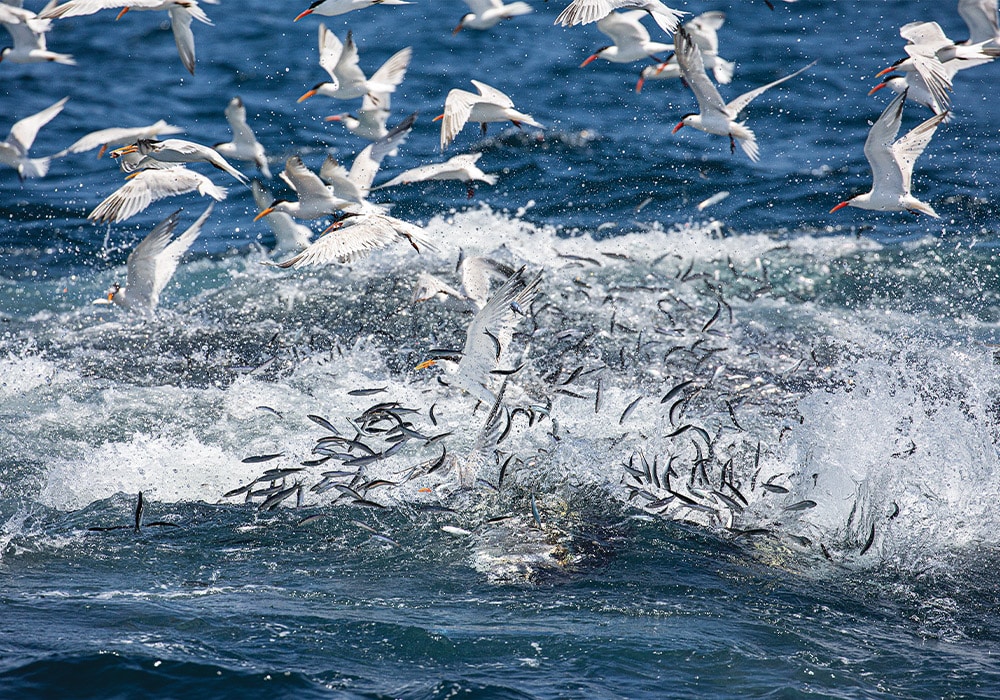
Live Flying Fish Stotesbury and his brother developed a tactic of using live flying fish to bait Pacific bluefin tuna. “We’ve found they will eat a big, live, locally caught flying fish when nothing else works,” Stotesbury says. “Nine of the 11 fish over 200 pounds we caught with live flying fish.”
Catching this winged bait is a time-consuming process the night before going fishing. “It’s a nightmare bait-catching operation,” Stotesbury says. “But the payoff can be huge.”
As darkness descends, Flying Fish cruises the northeastern side of San Clemente Island in 8- to 20-foot depths, using two high-powered spotlights to locate flyers at the surface.
Once a flying fish is spotted, the crew keeps the lights on it while the boat idles closer. With luck, the fish falls into a deer-in-the-headlights trance long enough for the crew to scoop it up with a net with a 12-foot handle, a 3-foot hoop and light nylon mesh.
The flyer then goes into the livewell, where it lives anywhere from eight to 12 hours. “If a bait dies, we remove it and put it on ice to use as a rigged bait later,” he explains.
The larger flyers produce the best on bluefin tuna, Stotesbury has learned.
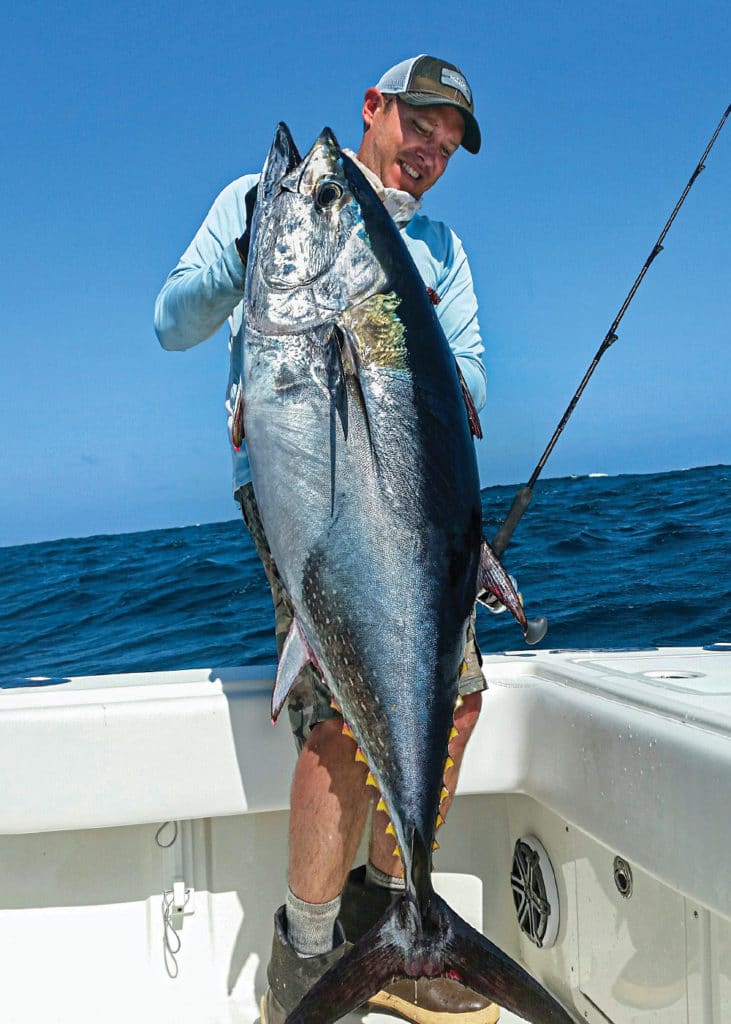
Find the Fish After catching bait, the crew searches for bluefins close to the island, using the fish finder to look for schools of bait and the tuna themselves, often finding them on the southwest, weather side of the island. “Wherever we find shoals of anchovies, we often find the bluefins,” Stotesbury says.
Typically, they fish three baits, one free-lined from each stern quarter, and one with a 1- to 2-ounce glow egg sinker (allowed to slide down to the hook) in the middle. They drop the baits back behind the boat at least 200 feet, sometimes more.
They bridle each bait through the eye socket with heavy rigging thread and an Owner 9/0 Super Mutu circle hook. Stotesbury uses a 15-foot, 200-pound-test fluorocarbon wind-on leader. “These baits live a long time in the water when you bridle them,” he says. “They actually do better on the bridle than they do in the bait tank.”
Because the Flying Fish crew adheres to the angling rules of the Avalon Tuna Club, they use Dacron main line and sometimes old-school linen line for certain club records. However, a more practical choice is 100- to 130-pound braid on a two-speed lever-drag reel matched to an all-roller, curved-butt rod rated for 100- to 250-pound braid.
Drift or Troll On breezy days, they might drift-fish, bumping the engines to keep the lines straight. On windless days, they slow-troll at dead-idle speed.
The crew stands vigilant for strikes, also watching for sea lions, sharks or birds. “If any other animal touches the bait, it’s ruined,” Stotesbury explains. “It injures the flying fish, and bluefin tuna won’t eat it.”
They fish with the reel in gear. The bluefins usually inhale a bait, so there’s little reason to give them any line. The circle hook sets itself.
Fly ‘Em High When flying fish are scarce, they rig a dead one so that the wings flare, and then fish it from a kite.
While some anglers staple wooden stir sticks on top of the wings to keep them extended, Stotesbury attaches a piece of light wire to the base of one wing, and runs the wire through the eye socket and back to the base of the opposite wing. He then tightens the wire and secures it with a twist to keep the wings flared.
Bridling the bait at the balance point through the back helps ensure that the flyer stays parallel to the surface. They use the same tackle as when fishing with live flying fish, except for tying in a swivel and adding a 2-ounce weight above it, and they fish only one bait at a time.
Read Next: Southern California Bluefin Tuna Fishing
“You have to mind the rod at all times,” Stotesbury says, “to keep the bait pancaked at the surface.” If the bait sinks, the wings get damaged as it is pulled back to the surface.
Whether fished alive or rigged dead, for the crew of Flying Fish, locally caught flying fish have become the hottest bait in one of today’s hottest West Coast fisheries. If you’re looking to tangle with a powerful Pacific bluefin tuna, put out a winged bait and get ready for action.
SWS Planner
What: Pacific bluefin tuna When: May through November Where: Off Southern California
Capt. Brandon Hayward Bight Sportfishing 949-212-0719 bightsportfishing.com
Capt. Todd Mansur Boardroom Fishing Charters 949-496-5794 boardroomfishingcharters.com
Capt. Duane Mellor Pinnacle Sportfishing 610-850-7575 pinnaclesportfishing.com
SWS Tackle Box
Reels: Shimano Talica 50 lever-drag two-speed, or equivalent Rods: Shimano Terez STXH2SS curved-butt rod rated for 100- to 250-pound braid, or equivalent Lines: 100- to 130-pound braided line Leader: 200-pound AFTCO Saiko fluorocarbon Hooks: Owner 9/0 Super Mutu circle hook, or equivalent Bait: Flying fish, fished live or rigged on a kite
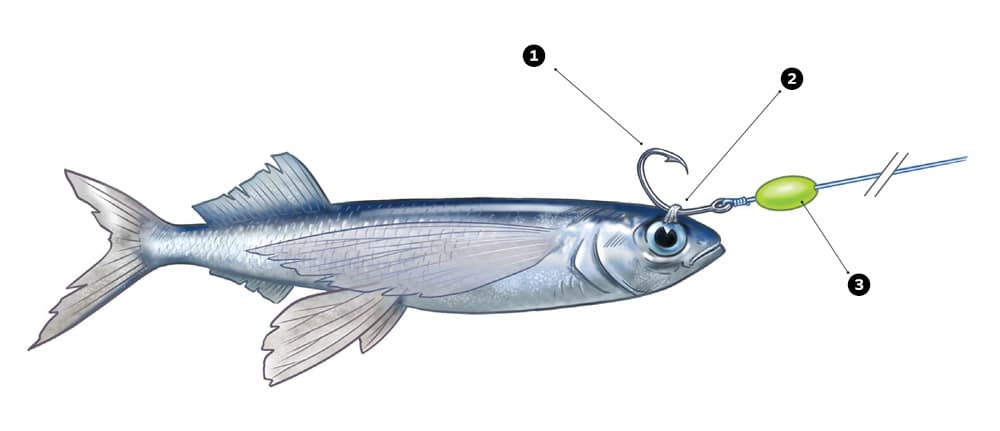
[1] 9/0 circle hook with the point facing upward
[2] Bridle through the eye sockets for optimal hook placement
[3] 1- to 2-ounce glow sinker Steve Sanford
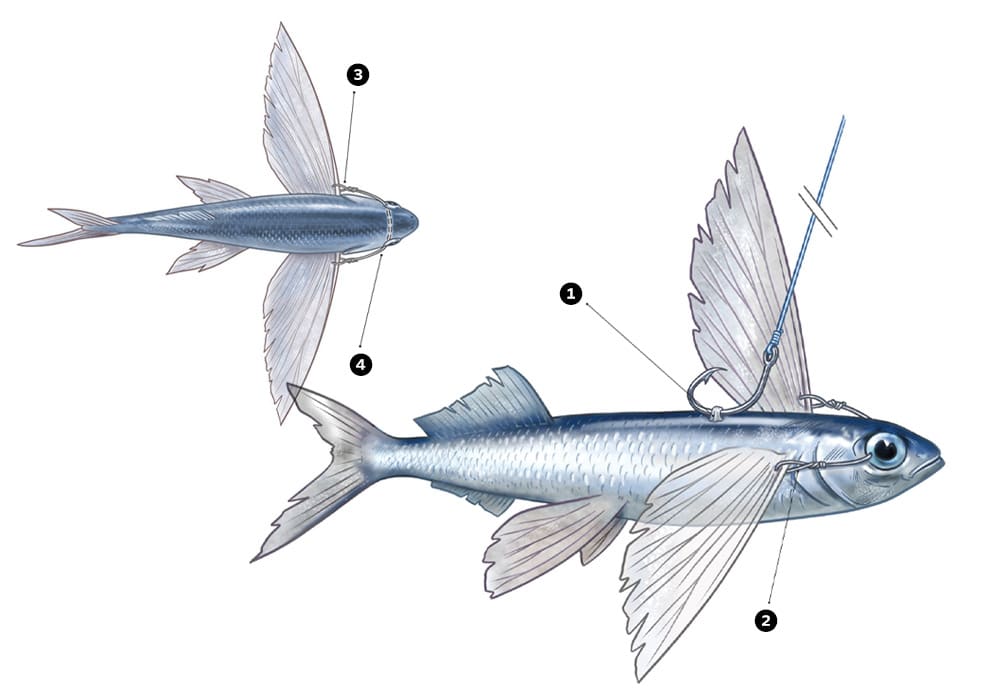
[1] Bridle a 9/0 circle hook on the back of the flying fish, just behind the wings
[2] Deploy the wings (pectoral fins) with rigging wire
[3] Twist wire around the leading spine of pectoral fins to keep them splayed
[4] Run rigging wire through the eye sockets Steve Sanford
Flying-Fish RigsLive flyers are trolled or drifted with a 9/0 circle hook bridled through the eye sockets, and a 1- to 2-ounce glow egg sinker in front. Dead flying fish are fished from a kite, with the hook bridled on the back, behind the wings, and wire through the eye sockets and affixed to the leading spine on both pectoral fins to keep the wings flared for a lifelike appearance.









